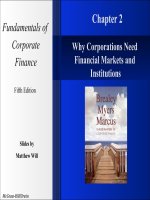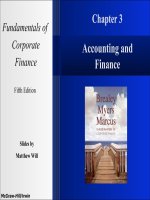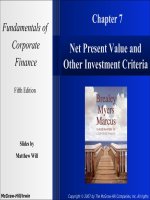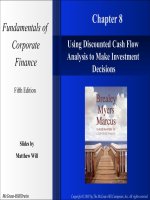Fundamentals of corporate finance 5e mcgraw chapter 06
Bạn đang xem bản rút gọn của tài liệu. Xem và tải ngay bản đầy đủ của tài liệu tại đây (599.64 KB, 32 trang )
Fundamentals of
Corporate
Finance
Chapter 6
Valuing Stocks
Fifth Edition
Slides by
Matthew Will
McGraw-Hill/Irwin
Copyright © 2007 by The McGraw-Hill Companies, Inc. All rights reserved
6- 2
Topics Covered
Stocks and the Stock Market
Book Values, Liquidation Values and
Market Values
Valuing Common Stocks
Simplifying the Dividend Discount Model
Growth Stocks and Income Stocks
There are no free lunches on Wall Street
Market Anomilies and Behavioral Finance
McGraw-Hill/Irwin
Copyright © 2007 by The McGraw-Hill Companies, Inc. All rights reserved
6- 3
Stocks & Stock Market
Primary Market - Place where the sale of new stock
first occurs.
Initial Public Offering (IPO) - First offering of stock
to the general public.
Seasoned Issue - Sale of new shares by a firm that
has already been through an IPO
McGraw-Hill/Irwin
Copyright © 2007 by The McGraw-Hill Companies, Inc. All rights reserved
6- 4
Stocks & Stock Market
Common Stock - Ownership shares in a
publicly held corporation.
Secondary Market - market in which already
issued securities are traded by investors.
Dividend - Periodic cash distribution from the
firm to the shareholders.
P/E Ratio - Price per share divided by
earnings per share.
McGraw-Hill/Irwin
Copyright © 2007 by The McGraw-Hill Companies, Inc. All rights reserved
6- 5
Stocks & Stock Market
Book Value - Net worth of the firm according
to the balance sheet.
Liquidation Value - Net proceeds that would
be realized by selling the firm’s assets and
paying off its creditors.
Market Value Balance Sheet - Financial
statement that uses market value of assets
and liabilities.
McGraw-Hill/Irwin
Copyright © 2007 by The McGraw-Hill Companies, Inc. All rights reserved
6- 6
Valuing Common Stocks
Expected Return - The percentage yield that an
investor forecasts from a specific investment over
a set period of time. Sometimes called the holding
period return (HPR).
Div1 + P1 − P0
Expected Return = r =
P0
McGraw-Hill/Irwin
Copyright © 2007 by The McGraw-Hill Companies, Inc. All rights reserved
6- 7
Valuing Common Stocks
The formula can be broken into two parts.
Dividend Yield + Capital Appreciation
Div1 P1 − P0
Expected Return = r =
+
P0
P0
McGraw-Hill/Irwin
Copyright © 2007 by The McGraw-Hill Companies, Inc. All rights reserved
6- 8
Valuing Common Stocks
Dividend Discount Model - Computation of today’s
stock price which states that share value equals the
present value of all expected future dividends.
Div1
Div2
Div H + PH
P0 =
+
+...+
1
2
H
(1 + r ) (1 + r )
(1 + r )
H - Time horizon for your investment.
McGraw-Hill/Irwin
Copyright © 2007 by The McGraw-Hill Companies, Inc. All rights reserved
6- 9
Valuing Common Stocks
Example
Current forecasts are for XYZ Company to pay
dividends of $3, $3.24, and $3.50 over the next
three years, respectively. At the end of three years
you anticipate selling your stock at a market price
of $94.48. What is the price of the stock given a
12% expected return?
McGraw-Hill/Irwin
Copyright © 2007 by The McGraw-Hill Companies, Inc. All rights reserved
6- 10
Valuing Common Stocks
Example
Current forecasts are for XYZ Company to pay dividends of $3, $3.24,
and $3.50 over the next three years, respectively. At the end of three
years you anticipate selling your stock at a market price of $94.48.
What is the price of the stock given a 12% expected return?
3.00
3.24
350
. + 94.48
PV =
+
+
1
2
3
(1+.12) (1+.12)
(1+.12)
PV = $75.00
McGraw-Hill/Irwin
Copyright © 2007 by The McGraw-Hill Companies, Inc. All rights reserved
6- 11
Blue Skies Value
Value per share, dollars
80
70
60
50
40
PV (Terminal Value)
PV (Dividends)
30
20
10
0
1
2
3
10
20
30
50
100
Investment Horizon, Years
McGraw-Hill/Irwin
Copyright © 2007 by The McGraw-Hill Companies, Inc. All rights reserved
6- 12
Valuing Common Stocks
If we forecast no growth, and plan to hold out
stock indefinitely, we will then value the stock as
a PERPETUITY.
Div1
EPS1
Perpetuity = P0 =
or
r
r
Assumes all earnings are
paid to shareholders.
McGraw-Hill/Irwin
Copyright © 2007 by The McGraw-Hill Companies, Inc. All rights reserved
6- 13
Valuing Common Stocks
Constant Growth DDM - A version of the
dividend growth model in which dividends
grow at a constant rate (Gordon Growth
Model).
Div1
P0 =
r−g
Given any combination of variables in the
equation, you can solve for the unknown variable.
McGraw-Hill/Irwin
Copyright © 2007 by The McGraw-Hill Companies, Inc. All rights reserved
6- 14
Valuing Common Stocks
Example
What is the value of a stock that expects to pay a
$3.00 dividend next year, and then increase the
dividend at a rate of 8% per year, indefinitely?
Assume a 12% expected return.
Div1
$3.00
P0 =
=
= $75.00
r − g .12 −.08
McGraw-Hill/Irwin
Copyright © 2007 by The McGraw-Hill Companies, Inc. All rights reserved
6- 15
Valuing Common Stocks
Example- continued
If the same stock is selling for $100 in the stock
market, what might the market be assuming about
the growth in dividends?
$3.00
$100 =
.12 − g
g =.09
McGraw-Hill/Irwin
Answer
The market is
assuming the dividend
will grow at 9% per
year, indefinitely.
Copyright © 2007 by The McGraw-Hill Companies, Inc. All rights reserved
6- 16
Valuing Common Stocks
If a firm elects to pay a lower dividend, and
reinvest the funds, the stock price may increase
because future dividends may be higher.
Payout Ratio - Fraction of earnings paid out as
dividends
Plowback Ratio - Fraction of earnings retained by
the firm.
McGraw-Hill/Irwin
Copyright © 2007 by The McGraw-Hill Companies, Inc. All rights reserved
6- 17
Valuing Common Stocks
Growth can be derived from applying the
return on equity to the percentage of
earnings plowed back into operations.
g = return on equity X plowback ratio
McGraw-Hill/Irwin
Copyright © 2007 by The McGraw-Hill Companies, Inc. All rights reserved
6- 18
Valuing Common Stocks
Example
Our company forecasts to pay a $5.00
dividend next year, which represents
100% of its earnings. This will
provide investors with a 12%
expected return. Instead, we decide to
plow back 40% of the earnings at the
firm’s current return on equity of
20%. What is the value of the stock
before and after the plowback
decision?
McGraw-Hill/Irwin
Copyright © 2007 by The McGraw-Hill Companies, Inc. All rights reserved
6- 19
Valuing Common Stocks
Example
Our company forecasts to pay a $5.00 dividend next year, which
represents 100% of its earnings. This will provide investors with a
12% expected return. Instead, we decide to blow back 40% of the
earnings at the firm’s current return on equity of 20%. What is the
value of the stock before and after the plowback decision?
No Growth
5
P0 =
= $41.67
.12
McGraw-Hill/Irwin
With Growth
g =.20×.40 =.08
3
P0 =
= $75.00
.12 −.08
Copyright © 2007 by The McGraw-Hill Companies, Inc. All rights reserved
6- 20
Valuing Common Stocks
Example - continued
If the company did not plowback some earnings,
the stock price would remain at $41.67. With the
plowback, the price rose to $75.00.
The difference between these two numbers (75.0041.67=33.33) is called the Present Value of
Growth Opportunities (PVGO).
McGraw-Hill/Irwin
Copyright © 2007 by The McGraw-Hill Companies, Inc. All rights reserved
6- 21
Valuing Common Stocks
Present Value of Growth Opportunities
(PVGO) - Net present value of a firm’s
future investments.
Sustainable Growth Rate - Steady rate at
which a firm can grow: plowback ratio X
return on equity.
McGraw-Hill/Irwin
Copyright © 2007 by The McGraw-Hill Companies, Inc. All rights reserved
6- 22
No Free Lunches
Technical Analysts
Forecast
stock prices based on the watching the
fluctuations in historical prices (thus “wiggle
watchers”)
watchers
McGraw-Hill/Irwin
Copyright © 2007 by The McGraw-Hill Companies, Inc. All rights reserved
6- 23
No Free Lunches
Scatter Plot of NYSE Composite Index over two successive weeks.
Where’s the pattern?
McGraw-Hill/Irwin
Copyright © 2007 by The McGraw-Hill Companies, Inc. All rights reserved
6- 24
Random Walk Theory
The movement of stock prices from day to
day DO NOT reflect any pattern.
Statistically speaking, the movement of
stock prices is random (skewed positive over the
long term).
McGraw-Hill/Irwin
Copyright © 2007 by The McGraw-Hill Companies, Inc. All rights reserved
6- 25
Random Walk Theory
Coin Toss Game
Heads
Heads
$106.09
$103.00
Tails
$100.43
$100.00
Heads
Tails
$97.50
Tails
McGraw-Hill/Irwin
$100.43
$95.06
Copyright © 2007 by The McGraw-Hill Companies, Inc. All rights reserved









